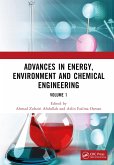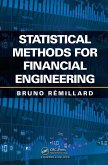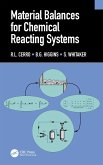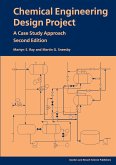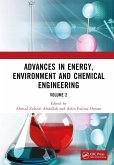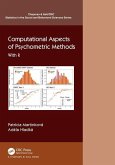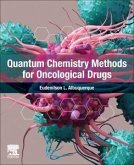Wim P. Krijnen (The Netherlands University of Groningen), Ernst C. Wit (Switzerland USI Universita della Svizzera italiana)
Computational and Statistical Methods for Chemical Engineering
Wim P. Krijnen (The Netherlands University of Groningen), Ernst C. Wit (Switzerland USI Universita della Svizzera italiana)
Computational and Statistical Methods for Chemical Engineering
- Gebundenes Buch
- Merkliste
- Auf die Merkliste
- Bewerten Bewerten
- Teilen
- Produkt teilen
- Produkterinnerung
- Produkterinnerung
Before the data revolution, most books focused either on mathematical modeling of chemical processes or exploratory chemometrics. This book aims to combine these two approaches and provide aspiring chemical engineers a single, comprehensive account of computational and statistical methods. Each chapter is accompanied by extensive exercises.
Andere Kunden interessierten sich auch für
![Advances in Energy, Environment and Chemical Engineering Volume 1 Advances in Energy, Environment and Chemical Engineering Volume 1]() Advances in Energy, Environment and Chemical Engineering Volume 1163,99 €
Advances in Energy, Environment and Chemical Engineering Volume 1163,99 €![Statistical Methods for Financial Engineering Statistical Methods for Financial Engineering]() Bruno RemillardStatistical Methods for Financial Engineering54,99 €
Bruno RemillardStatistical Methods for Financial Engineering54,99 €![Material Balances for Chemical Reacting Systems Material Balances for Chemical Reacting Systems]() R.L. CerroMaterial Balances for Chemical Reacting Systems106,99 €
R.L. CerroMaterial Balances for Chemical Reacting Systems106,99 €![Chemical Engineering Design Project Chemical Engineering Design Project]() Martyn S RayChemical Engineering Design Project117,99 €
Martyn S RayChemical Engineering Design Project117,99 €![Advances in Energy, Environment and Chemical Engineering Volume 2 Advances in Energy, Environment and Chemical Engineering Volume 2]() Advances in Energy, Environment and Chemical Engineering Volume 2143,99 €
Advances in Energy, Environment and Chemical Engineering Volume 2143,99 €![Computational Aspects of Psychometric Methods Computational Aspects of Psychometric Methods]() Patricia Martinkova (Sr. researcher, Institute Comp. Sci, Czech AcaComputational Aspects of Psychometric Methods82,99 €
Patricia Martinkova (Sr. researcher, Institute Comp. Sci, Czech AcaComputational Aspects of Psychometric Methods82,99 €![Quantum Chemistry Methods for Oncological Drugs Quantum Chemistry Methods for Oncological Drugs]() Eudenilson L. Albuquerque (Universidade Federal do Rio Grande do NoQuantum Chemistry Methods for Oncological Drugs191,99 €
Eudenilson L. Albuquerque (Universidade Federal do Rio Grande do NoQuantum Chemistry Methods for Oncological Drugs191,99 €-
-
-
Before the data revolution, most books focused either on mathematical modeling of chemical processes or exploratory chemometrics. This book aims to combine these two approaches and provide aspiring chemical engineers a single, comprehensive account of computational and statistical methods. Each chapter is accompanied by extensive exercises.
Hinweis: Dieser Artikel kann nur an eine deutsche Lieferadresse ausgeliefert werden.
Hinweis: Dieser Artikel kann nur an eine deutsche Lieferadresse ausgeliefert werden.
Produktdetails
- Produktdetails
- Verlag: Taylor & Francis Ltd
- Seitenzahl: 26
- Erscheinungstermin: 19. Dezember 2022
- Englisch
- Abmessung: 162mm x 241mm x 27mm
- Gewicht: 706g
- ISBN-13: 9781032013244
- ISBN-10: 1032013249
- Artikelnr.: 65919363
- Herstellerkennzeichnung
- Libri GmbH
- Europaallee 1
- 36244 Bad Hersfeld
- gpsr@libri.de
- Verlag: Taylor & Francis Ltd
- Seitenzahl: 26
- Erscheinungstermin: 19. Dezember 2022
- Englisch
- Abmessung: 162mm x 241mm x 27mm
- Gewicht: 706g
- ISBN-13: 9781032013244
- ISBN-10: 1032013249
- Artikelnr.: 65919363
- Herstellerkennzeichnung
- Libri GmbH
- Europaallee 1
- 36244 Bad Hersfeld
- gpsr@libri.de
Wim P. Krijnen is a lecturer at the Faculty of Science and Engineering at the University of Groningen. He has been teaching a course called "Computational and Statistical Methods" for several years to undergraduate students in Chemical Engineering. In addition, he has taught courses on linear algebra, probability theory, mathematical statistics, statistical modeling, statistical consulting to bachelor's and master's students in various fields. He is a professor of Applied Statistical Research Methods at the Hanze University of Applied Sciences in Groningen. Ernst C. Wit is the Fondazione Leonardo Professor of Data Science at the Universita della Svizzera italiana in Switzerland. He has 30 years of experience in teaching statistics, applied mathematics and data science courses to students from many fields, including chemical engineering. His course in philopsophy is about combining theoretical insights with practical skills, as he believes that the former without the latter is pointless whereas the latter without the former aimless.
I. Preliminaries. 1. What to expect in this book? 2. Calculus and Linear
Algebra Essentials. 2.1. Scalars, Vectors and Matrices. 2.2. Sequences and
Series. 2.3. Functions. 2.4. Differentiation. 2.5. Maxima and Minima. 2.6.
Integration. 2.7. Differential Equations. 2.8. Complex Numbers and
Functions. 2.9. Exercises. 3. Probability Essentials. 3.1. Probability of
Events. 3.2. Random Variables. 3.3. Pseudo Random Number Generation. 3.4.
Notes and Comments. 3.5. Notes on Using R. 3.6. Exercises. II. Numerics and
Error Propagation. 4. Introduction to Numerical Methods. 4.1. Fixed Point
Problems. 4.2. Numerical Methods for Solving Differential Equations. 4.3.
Differential Algebraic Equations. 4.4. Notes and Comments. 4.5. Notes on
Using R. 4.6. Exercises. 5. Laws on propagation of Error. 5.1. Absolute and
Relative Error of Measurement. 5.2. Mean and Variance. 5.3. Functions that
Depend on One Variable. 5.4. Functions that Depend on Two Variables. 5.5.
Notes and Comments. 5.6. Notes on Using R. 5.7. Exercises. III. Various
Types of Models and their Estimation. 6. Measurement Models for a Chemical
Quantity. 6.1. Measurement Model. 6.2. Law of Large Numbers. 6.3.
Constructing Confidence Intervals. 6.4. Testing Chemical Hypotheses related
to Measurement Models. 6.5. General Inference Paradigm. 6.6. Notes and
Comments. 6.7. Notes on Using R. 6.8. Exercises. 7. Linear Models. 7.1.
Linear Model. 7.2. Estimation and Prediction. 7.3. Model Diagnostics. 7.4.
Model Selection. 7.5. Specific Linear Models. 7.6. Notes and Comments. 7.7.
Notes on Using R. 7.8. Exercises. 8. Non-linear Models. 8.1. Some
non-linear Functions Modeling chemical Processes. 8.2. Non-linear
Regression. 8.3. Inverse Regression. 8.4. Generalized Linear Models. 9.
Chemodynamics and Stoichiometry. 9.1. Stoichiometry of Systems of
Reactions. 9.2. Stochastic Models for Particle Dynamics. 9.3. Estimating
Reaction Rates. 9.4. Mean-field Approximation of Reaction System. 10.
Multivariate Exploration. 10.1. Data Visualisation. 10.2. Matrix
Decomposition. 10.3. Principal Components Analysis. 10.4. Regression using
a Subspace. 10.5. Notes and Comments. 10.6. Notes on Using R. 10.7.
Exercises. IV. Analysis of Designed Experiments. 11. Analysis of Data from
Designed Experiments. 11.1. Concepts of Factorial Designs. 11.2. Analysis
of Variance. 11.3. Analysis of the Response Surface. 11.4. Mixed Effects
Models. 11.5. Notes and Comments. 11.6. Notes on Using R. 11.7. Exercises.
12. Robust Analysis of Models. 12.1. Outlying Data Points. 12.2. Robust
Estimation. 12.3. Robust Linear Regression. 12.4. Robust Nonlinear
Regression. 12.5. Dealing with Heterogeneity. 12.6. Appendix: Scale Tau
Estimator. 12.7. Notes and Comments. 12.8. Notes on Using R. 12.9.
Exercises. V. Appendix. 13. Basics of R Computing Environment. 13.1. R
Basics. 13.2. Useful Functions. 13.3. Model Notation.13.4. Finding Help.
13.5. Exercises
Algebra Essentials. 2.1. Scalars, Vectors and Matrices. 2.2. Sequences and
Series. 2.3. Functions. 2.4. Differentiation. 2.5. Maxima and Minima. 2.6.
Integration. 2.7. Differential Equations. 2.8. Complex Numbers and
Functions. 2.9. Exercises. 3. Probability Essentials. 3.1. Probability of
Events. 3.2. Random Variables. 3.3. Pseudo Random Number Generation. 3.4.
Notes and Comments. 3.5. Notes on Using R. 3.6. Exercises. II. Numerics and
Error Propagation. 4. Introduction to Numerical Methods. 4.1. Fixed Point
Problems. 4.2. Numerical Methods for Solving Differential Equations. 4.3.
Differential Algebraic Equations. 4.4. Notes and Comments. 4.5. Notes on
Using R. 4.6. Exercises. 5. Laws on propagation of Error. 5.1. Absolute and
Relative Error of Measurement. 5.2. Mean and Variance. 5.3. Functions that
Depend on One Variable. 5.4. Functions that Depend on Two Variables. 5.5.
Notes and Comments. 5.6. Notes on Using R. 5.7. Exercises. III. Various
Types of Models and their Estimation. 6. Measurement Models for a Chemical
Quantity. 6.1. Measurement Model. 6.2. Law of Large Numbers. 6.3.
Constructing Confidence Intervals. 6.4. Testing Chemical Hypotheses related
to Measurement Models. 6.5. General Inference Paradigm. 6.6. Notes and
Comments. 6.7. Notes on Using R. 6.8. Exercises. 7. Linear Models. 7.1.
Linear Model. 7.2. Estimation and Prediction. 7.3. Model Diagnostics. 7.4.
Model Selection. 7.5. Specific Linear Models. 7.6. Notes and Comments. 7.7.
Notes on Using R. 7.8. Exercises. 8. Non-linear Models. 8.1. Some
non-linear Functions Modeling chemical Processes. 8.2. Non-linear
Regression. 8.3. Inverse Regression. 8.4. Generalized Linear Models. 9.
Chemodynamics and Stoichiometry. 9.1. Stoichiometry of Systems of
Reactions. 9.2. Stochastic Models for Particle Dynamics. 9.3. Estimating
Reaction Rates. 9.4. Mean-field Approximation of Reaction System. 10.
Multivariate Exploration. 10.1. Data Visualisation. 10.2. Matrix
Decomposition. 10.3. Principal Components Analysis. 10.4. Regression using
a Subspace. 10.5. Notes and Comments. 10.6. Notes on Using R. 10.7.
Exercises. IV. Analysis of Designed Experiments. 11. Analysis of Data from
Designed Experiments. 11.1. Concepts of Factorial Designs. 11.2. Analysis
of Variance. 11.3. Analysis of the Response Surface. 11.4. Mixed Effects
Models. 11.5. Notes and Comments. 11.6. Notes on Using R. 11.7. Exercises.
12. Robust Analysis of Models. 12.1. Outlying Data Points. 12.2. Robust
Estimation. 12.3. Robust Linear Regression. 12.4. Robust Nonlinear
Regression. 12.5. Dealing with Heterogeneity. 12.6. Appendix: Scale Tau
Estimator. 12.7. Notes and Comments. 12.8. Notes on Using R. 12.9.
Exercises. V. Appendix. 13. Basics of R Computing Environment. 13.1. R
Basics. 13.2. Useful Functions. 13.3. Model Notation.13.4. Finding Help.
13.5. Exercises
I. Preliminaries. 1. What to expect in this book? 2. Calculus and Linear
Algebra Essentials. 2.1. Scalars, Vectors and Matrices. 2.2. Sequences and
Series. 2.3. Functions. 2.4. Differentiation. 2.5. Maxima and Minima. 2.6.
Integration. 2.7. Differential Equations. 2.8. Complex Numbers and
Functions. 2.9. Exercises. 3. Probability Essentials. 3.1. Probability of
Events. 3.2. Random Variables. 3.3. Pseudo Random Number Generation. 3.4.
Notes and Comments. 3.5. Notes on Using R. 3.6. Exercises. II. Numerics and
Error Propagation. 4. Introduction to Numerical Methods. 4.1. Fixed Point
Problems. 4.2. Numerical Methods for Solving Differential Equations. 4.3.
Differential Algebraic Equations. 4.4. Notes and Comments. 4.5. Notes on
Using R. 4.6. Exercises. 5. Laws on propagation of Error. 5.1. Absolute and
Relative Error of Measurement. 5.2. Mean and Variance. 5.3. Functions that
Depend on One Variable. 5.4. Functions that Depend on Two Variables. 5.5.
Notes and Comments. 5.6. Notes on Using R. 5.7. Exercises. III. Various
Types of Models and their Estimation. 6. Measurement Models for a Chemical
Quantity. 6.1. Measurement Model. 6.2. Law of Large Numbers. 6.3.
Constructing Confidence Intervals. 6.4. Testing Chemical Hypotheses related
to Measurement Models. 6.5. General Inference Paradigm. 6.6. Notes and
Comments. 6.7. Notes on Using R. 6.8. Exercises. 7. Linear Models. 7.1.
Linear Model. 7.2. Estimation and Prediction. 7.3. Model Diagnostics. 7.4.
Model Selection. 7.5. Specific Linear Models. 7.6. Notes and Comments. 7.7.
Notes on Using R. 7.8. Exercises. 8. Non-linear Models. 8.1. Some
non-linear Functions Modeling chemical Processes. 8.2. Non-linear
Regression. 8.3. Inverse Regression. 8.4. Generalized Linear Models. 9.
Chemodynamics and Stoichiometry. 9.1. Stoichiometry of Systems of
Reactions. 9.2. Stochastic Models for Particle Dynamics. 9.3. Estimating
Reaction Rates. 9.4. Mean-field Approximation of Reaction System. 10.
Multivariate Exploration. 10.1. Data Visualisation. 10.2. Matrix
Decomposition. 10.3. Principal Components Analysis. 10.4. Regression using
a Subspace. 10.5. Notes and Comments. 10.6. Notes on Using R. 10.7.
Exercises. IV. Analysis of Designed Experiments. 11. Analysis of Data from
Designed Experiments. 11.1. Concepts of Factorial Designs. 11.2. Analysis
of Variance. 11.3. Analysis of the Response Surface. 11.4. Mixed Effects
Models. 11.5. Notes and Comments. 11.6. Notes on Using R. 11.7. Exercises.
12. Robust Analysis of Models. 12.1. Outlying Data Points. 12.2. Robust
Estimation. 12.3. Robust Linear Regression. 12.4. Robust Nonlinear
Regression. 12.5. Dealing with Heterogeneity. 12.6. Appendix: Scale Tau
Estimator. 12.7. Notes and Comments. 12.8. Notes on Using R. 12.9.
Exercises. V. Appendix. 13. Basics of R Computing Environment. 13.1. R
Basics. 13.2. Useful Functions. 13.3. Model Notation.13.4. Finding Help.
13.5. Exercises
Algebra Essentials. 2.1. Scalars, Vectors and Matrices. 2.2. Sequences and
Series. 2.3. Functions. 2.4. Differentiation. 2.5. Maxima and Minima. 2.6.
Integration. 2.7. Differential Equations. 2.8. Complex Numbers and
Functions. 2.9. Exercises. 3. Probability Essentials. 3.1. Probability of
Events. 3.2. Random Variables. 3.3. Pseudo Random Number Generation. 3.4.
Notes and Comments. 3.5. Notes on Using R. 3.6. Exercises. II. Numerics and
Error Propagation. 4. Introduction to Numerical Methods. 4.1. Fixed Point
Problems. 4.2. Numerical Methods for Solving Differential Equations. 4.3.
Differential Algebraic Equations. 4.4. Notes and Comments. 4.5. Notes on
Using R. 4.6. Exercises. 5. Laws on propagation of Error. 5.1. Absolute and
Relative Error of Measurement. 5.2. Mean and Variance. 5.3. Functions that
Depend on One Variable. 5.4. Functions that Depend on Two Variables. 5.5.
Notes and Comments. 5.6. Notes on Using R. 5.7. Exercises. III. Various
Types of Models and their Estimation. 6. Measurement Models for a Chemical
Quantity. 6.1. Measurement Model. 6.2. Law of Large Numbers. 6.3.
Constructing Confidence Intervals. 6.4. Testing Chemical Hypotheses related
to Measurement Models. 6.5. General Inference Paradigm. 6.6. Notes and
Comments. 6.7. Notes on Using R. 6.8. Exercises. 7. Linear Models. 7.1.
Linear Model. 7.2. Estimation and Prediction. 7.3. Model Diagnostics. 7.4.
Model Selection. 7.5. Specific Linear Models. 7.6. Notes and Comments. 7.7.
Notes on Using R. 7.8. Exercises. 8. Non-linear Models. 8.1. Some
non-linear Functions Modeling chemical Processes. 8.2. Non-linear
Regression. 8.3. Inverse Regression. 8.4. Generalized Linear Models. 9.
Chemodynamics and Stoichiometry. 9.1. Stoichiometry of Systems of
Reactions. 9.2. Stochastic Models for Particle Dynamics. 9.3. Estimating
Reaction Rates. 9.4. Mean-field Approximation of Reaction System. 10.
Multivariate Exploration. 10.1. Data Visualisation. 10.2. Matrix
Decomposition. 10.3. Principal Components Analysis. 10.4. Regression using
a Subspace. 10.5. Notes and Comments. 10.6. Notes on Using R. 10.7.
Exercises. IV. Analysis of Designed Experiments. 11. Analysis of Data from
Designed Experiments. 11.1. Concepts of Factorial Designs. 11.2. Analysis
of Variance. 11.3. Analysis of the Response Surface. 11.4. Mixed Effects
Models. 11.5. Notes and Comments. 11.6. Notes on Using R. 11.7. Exercises.
12. Robust Analysis of Models. 12.1. Outlying Data Points. 12.2. Robust
Estimation. 12.3. Robust Linear Regression. 12.4. Robust Nonlinear
Regression. 12.5. Dealing with Heterogeneity. 12.6. Appendix: Scale Tau
Estimator. 12.7. Notes and Comments. 12.8. Notes on Using R. 12.9.
Exercises. V. Appendix. 13. Basics of R Computing Environment. 13.1. R
Basics. 13.2. Useful Functions. 13.3. Model Notation.13.4. Finding Help.
13.5. Exercises


